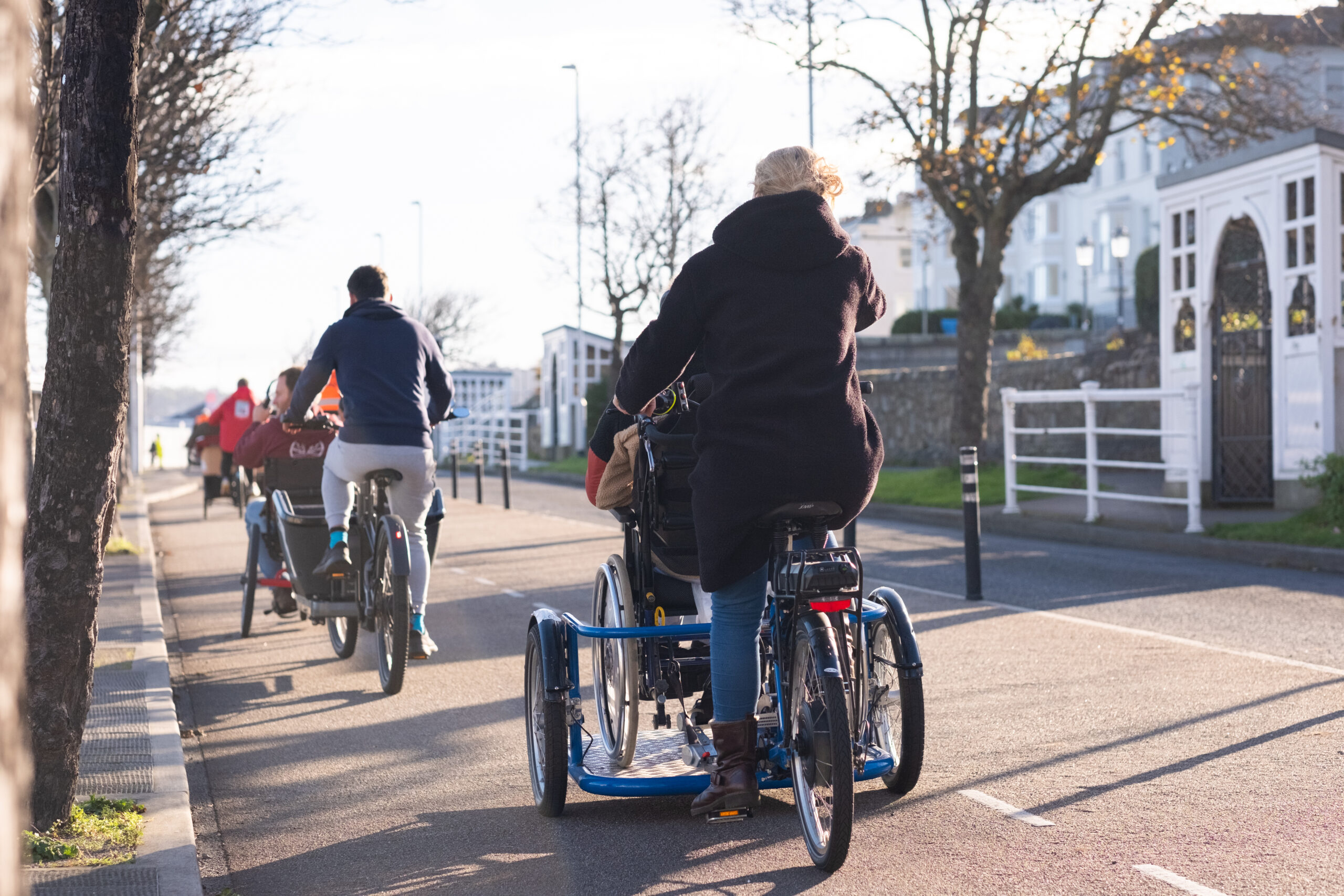In our work on Active Travel projects over the past decade, we’ve seen towns and cities across Ireland embrace more sustainable transport options and start to truly transform how Ireland moves.
But conversations about Active Travel – walking, cycling, scooting, and wheeling – can often bump up against persistent misconceptions. Let’s examine six common myths and uncover the facts behind them.
Myth 1: Active Travel Infrastructure Hurts Local Business
Research shows people on foot and on bikes tend to visit shops more frequently and spend more per square meter of parking than drivers – cycle parking can deliver five times higher retail spending per square meter than car parking.
Compact towns that have been designed for walking and cycling achieve 2.5 times higher retail density than typical urban centres that are more focused on car transportation.
Active Travel measures introduced on Dublin’s Coastal mobility Route saw many businesses report increased footfall and revenue. In New York city, trade increased by 49% for local businesses.
The evidence is clear: well-designed active travel infrastructure can create more vibrant, profitable local economies. So active travel infrastructure doesn’t necessarily hurt local businesses – it often boosts them and can create more vibrant, profitable local economies.
Myth 2: Active Travel Infrastructure Excludes the Elderly and Those with Mobility Challenges
Active Travel infrastructure gives less-able people more transport options and independence.
Well-designed infrastructure can significantly enhance mobility and independence for people with disabilities, the elderly, and others with special mobility needs by creating safer, calmer streets with features like step-free crossings, wide paths, and smooth surfaces.
It promotes accessibility beyond cars by supporting mobility aids, adaptive bikes, and trishaws while reducing isolation and improving health through safe, social outdoor spaces.
In the Netherlands, where high-quality cycling infrastructure is the norm, a third of trips by people aged 65-75 are made by bicycle – the highest among all adult categories. In Ireland, initiatives like Cycling Without Age demonstrate how active travel can be inclusive, empowering elderly and less mobile people to participate through specially designed solutions like trishaws.
Thoughtful design ensures active travel routes are accessible and beneficial for everyone, fostering healthier, more connected communities.
Myth 3: Active Travel Infrastructure Causes More Traffic Congestion
The data tells a different story. A typical motor vehicle lane can carry around 2,000 people per hour, while the same space allocated to cycling infrastructure could move 10,000 people.
Road congestion is due to motor traffic, particularly queues at junctions. While driving behind someone cycling is going to temporarily slow you down if you’re in a car or on a bus, it is unlikely to add any significant overall delay to your journey. Congestion primarily results from too many motor vehicles, with too few people in them, competing for limited space.
Low-Traffic Neighbourhoods (LTNs) are becoming increasingly popular. In the UK, a YouGov poll found that once implemented, positive views on LTNs are three times higher than negative ones.
Well-designed cycling and walking infrastructure actually helps reduce congestion by giving people real alternatives to driving, helping to make cities greener, and to prioritise people over cars.
Myth 4: Cyclists Pose a Danger to Pedestrians
Conflict between cyclists and pedestrians is almost always a symptom of poor urban design.
Shared or pedestrianised spaces can be thoughtfully designed with clear markings, planting features, and bike parking to encourage cyclists to go slow or dismount.
The safest option for cyclists is either to have bike lanes separated from motor traffic, or by making the road itself a pleasant place to cycle by reducing the speed and volume of motor traffic to a low level.
Research shows that building proper cycling infrastructure reduces pavement cycling and creates safer environments for everyone.
Myth 5: Irish Weather Makes Active Travel Impractical
People still walk whether it’s rainy, or cold, or hot – and they still cycle too. While Ireland’s weather can be unpredictable, research from cities with high-quality cycling infrastructure shows that people continue to cycle regularly even if the weather is bad. For example, Copenhagen and Amsterdam, two cities where more than 40% of commuters are cyclists, have on average more ‘wet days’ than Dublin.
It’s the quality of infrastructure, not the weather, that most influences active travel participation. People still walk and cycle in towns and cities with similar or worse weather patterns as Ireland, when proper facilities exist.
Myth 6: Cyclists Don’t Follow Rules
Studies paint a different picture. In Ireland, the 2018 free speed survey shows 52% of car drivers breaking the speed limit on urban roads.
A Danish Road Directorate study found that less than 5% of cyclists break traffic laws when riding on proper cycleways, compared to 66% of motorists breaking driving rules.
This figure only rises to 14% when no cycling infrastructure exists. Good public infrastructure, designed with cycling in mind as a valid mode of transport, makes rule-breaking less attractive and/or necessary.
Active Travel in Ireland: The Data
Recent data from the National Transport Authority’s Walking and Cycling Index 2023 shows strong public support for active travel infrastructure.
In Galway, 88% of residents support building segregated cycle tracks, even if it means less space for other traffic. The benefits are substantial: Active Travel in Dublin alone creates an annual economic benefit of €2.39 billion and saves the HSE €64.5`million in healthcare costs.
In Dublin, 74% of residents aged over 66 now walk or wheel at least 5 days a week, up from 10% in 2021.
In Cork, Waterford and Limerick, Active Travel is bringing economic benefits: there is a €1.40 net economic benefit for each kilometre cycled instead of driven and €0.93 net economic benefit for each kilometre walked instead of driven.
There are benefits to the environment too: every day those who walk and cycle in Dublin take nearly 530,000 cars off the road, saving greenhouse gas emissions equivalent to 1.69 million flights from Dublin Airport to London Heathrow Airport.
As Ireland implements its National Sustainable Mobility Action Plan, understanding the reality behind these myths becomes crucial. Active Travel infrastructure, when well-designed and properly implemented, creates more accessible, economically vibrant, and sustainable communities for everyone.
The evidence is clear: active travel infrastructure isn’t just about cycling or walking – it’s about building better, more liveable cities for all, regardless of how they choose to move around.
Let’s focus on creating the infrastructure needed for a more sustainable and accessible future for everyone.
If you have an Active Travel project that you think we could help with – get in touch with us at info@mco.ie.

